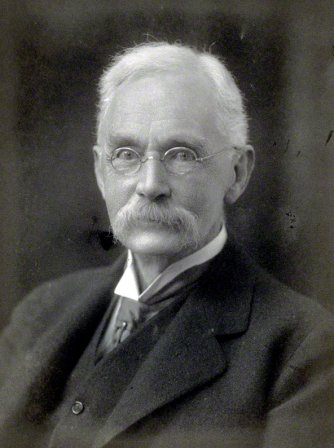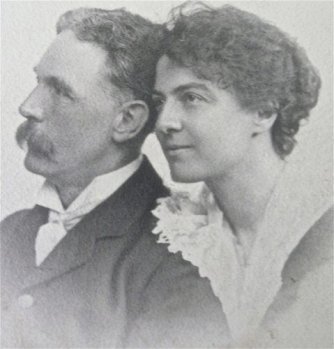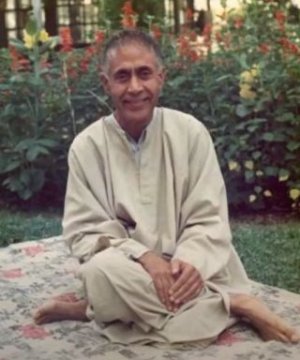| Library / Biographies |
Thomas William Rhys Davids Biography

Thomas William Rhys Davids was born at Colchester in Essex, England, on May 12, 1843, the eldest son of a Congregational clergyman from Wales, who was affectionately referred to as the Bishop of Essex.
His mother, who died at the age of 37 following childbirth, had run the Sunday school at his father's church.
Deciding on a Civil Service career, Rhys Davids studied Sanskrit under A.F. Stenzler, a distinguished scholar at the University of Breslau 1, and achieved the degree of Ph.D. He earned money in Breslau by teaching English.
In 1863 Rhys Davids returned to Britain, and on passing his civil service exams was posted to Sri Lanka (then known as Ceylon) in 1864.
When he was Magistrate of Galle and a case was brought before him involving questions of ecclesiastical law, about the occupation of a village vihara 2, he first learned of the Pāli 3 language when a document in that language was brought in as evidence.
He received the assistance of Venerable Yātrāmule Unnānse Sri Dhammarama, a Pāli scholar: “I had heard of his learning as a Pāli scholar, and of his illness, and was grateful to him for leaving his home under such circumstances, to teach a stranger. There was a strange light in his sunken eyes, and he was constantly turning away from questions about Pāli to questions about Buddhism. I found him versed in all the poetry and ethics of the Suttas and was glad to hear him talk. There was an indescribable attraction about him, a simplicity, a high-mindedness, that filled me with reverence.”
Venerable Yātrāmule told him: "Go and talk to the yellow robed and tonsured recluse - not of course through an interpreter, or out of a book of phrases: you must know not only his language but something of Buddhist ideas; and you must speak to him as man to man, not as the wise to the barbarian. You will certainly be courteous; for whatever else a Buddhist Bhikkhu may be, he will be sure to give proof of courtesy and a dignified demeanor. And it will be strange if you do not find a new world of thought and of feeling opening out before you."
He started studying the language intensely and was intrigued by the vast and deep wisdom of Buddha’s teachings. As his knowledge and understanding of Buddhism gradually expanded, the son of a Welsh Congregational clergyman was convinced that this teaching was beyond the realm of faith and was indeed the “wisdom-jewel” of humanity.
In 1871 he was posted as Assistant Government Agent of Nuwarakalaviya, where Anuradhapura was the administrative center. The governor was Sir Hercules Robinson, who had founded the Archaeological Commission in 1868.
Rhys Davids became involved with the excavation of the ancient Sinhalese city of Anuradhapura, which had been abandoned after an invasion in 993 CE. He began to collect inscriptions and manuscripts, and from 1870-1872 wrote a series of articles for the Ceylon branch of the Royal Asiatic Society Journal about them. He learned the local language and spent time with the people.
Rhys Davids' interest was not confined only to antiquities. As Assistant Government Agent of Anuradhapura he tried to improve the economic conditions of the people by fostering paddy cultivation, improving irrigation, introducing new crops like tobacco and cotton and also introducing cattle rearing.
Rhys Davids' civil service career and his residence in Sri Lanka ended abruptly. Personal differences with his superior, C. W. Twynham, caused a formal investigation, resulting in a tribunal and Rhys Davids' dismissal for misconduct. A number of minor offenses had been discovered, as well as grievances concerning fines improperly exacted both from Rhys Davids' subjects and his employees 4.
In 1875 he wrote papers for the Journal of the Royal Asiatic Society on “Inscriptions of Parākrama Bāhu,” Sigiri, the Lion Rock,” and “Two Old Sinhalese Inscriptions.”
In 1877 he published in the International Numismata Orientalia, an essay on "The Ancient Coins and Measures of Ceylon".
He wrote his first book on Buddhism “The Life and Teachings of the Buddha” for the Society for Promoting Christian Knowledge, in the series on non-Christian religions. It gives in compact form, the life of the Buddha, the essence of his teaching and the formation of the order of monks.
In 1877 he also studied law and was called to the bar, but a legal career, though lucrative did not appeal to him. His interests centered around Buddhism and the field of Pali canonical literature. His wife Caroline Rhys Davids said that, "Rhys Davids was haunted and pursued by the spiritual legacy bequeathed to him from Ceylon."
He continued to publish articles about Sri Lankan inscriptions and translations, notably in Max Müller's Sacred Books of the East 5.
He translated into English the first volume of Jatakas edited by Fousball in 1880 under the title "Buddhist Birth Stories" and proceeded to translate selected parts of the Sutta Pitaka which formed Vol. II of the Sacred Books of the East Series.
In 1881 he was invited to deliver the prestigious Hibbert Lectures. His subject was "The origin and Growth of Religion as illustrated by some points in the History of Indian Buddhism".
In 1881, with the support of many distinguished scholars from England, France, Holland, Germany and the US who were interested in Oriental Studies, Rhys Davids established the Pali Text Society on the model of the English Text Society 6, "to foster and promote the study of Pāli texts".
Rhys Davids said: "The sacred books of the early Buddhists have preserved to us the sole record of the only religious movement in the world's history which bears any close resemblance to Christianity; and it is not too much to say that the publication of this unique literature will be no less important for the study of history and specially religious history than the publication of the Vedas has already been".
Professor Dr. Hammalava Saddatissa Mahanayaka Thera7 considered Rhys Davids being the "greatest translator of Pali Texts and founder of Pali Text Society which has edited and translated virtually the whole of the Canon" [the Tripitaka].
From 1882 to 1904 Rhys Davids was Professor of Pāli at the University of London, a post which did not provide a fixed salary other than lecture fees.
In 1887 Rhys Davids was unanimously elected Secretary of the Royal Asiatic Society Council.

William Rhys Davids married Caroline Augusta Foley in 1894. They had three children: Vivien Brynhild Caroline Foley Rhys Davids (1895-1978), Arthur Rhys Davids (1897-1917), and Nesta Enid (1900-1973).8
He promoted Theravada Buddhism and Pāli scholarship in Britain and actively lobbied the government (in co-operation with the Asiatic Society of Great Britain) to expand funding for the study of Indian languages and literature, using numerous arguments over how this might strengthen the British hold on India.
As a result of the lobbying of the Royal Asiatic Society and Rhys Davids, the government accepted the proposal for an independent oriental school in 1908 and established London School of Oriental (and later) African studies.
He gave "Historical Lectures" and wrote papers advancing a racial theory of a common "Aryan" ethnicity amongst the peoples of Britain, Sri Lanka, and the Buddha's own clan in ancient times. These were comparable to the racial theories of Max Müller, but were used to a different purpose. Rhys Davids claimed that Britons had a natural, "racial" affinity with Buddhist doctrine. This part of Rhys Davids' career is controversial.
In 1905 Rhys Davids resigned from the Royal Asiatic Society to accept the Chair of Comparative Religion in the University of Manchester of which he was the first distinguished incumbent. This new position provided him with a reasonable income.
At Manchester, while teaching the history of religions Rhys Davids wrote “Early Buddhism” book (1908) and a chapter for “The Cambridge History of India” on the Early History of Buddhism. His greatest achievement was the Pali English Dictionary on which he labored for 40 years with the collaboration of other renowned scholars.
Unfortunately, he died before he could finish his work, but the task was completed by his student William Stede in 1925. It superseded the first Pāli-English dictionary published in 1874 by Robert Caesar Childers (1838–1876).
In 1915 Rhys Davids left Manchester. Many years before the University of Edinburgh conferred on him a LLD and Manchester made him a Doctor of Letters.
Rhys Davids died on 27 December 1922 in Chipstead, Surrey.
At the time of his death the Pali Text Society had issued 64 separate texts in ninety four volumes extending over 26,000 pages besides many articles and notes by European and Oriental scholars.
Works (alphabetical order)
• Asoka and the Buddha-relics, Journal of the Royal Asiatic Society, 1901
• Buddhism: being a sketch of the life and teachings of Gautama, the Buddha, London, 1890
• Buddhism: its history and literature, New York, London, 1896
• Buddhist & Christian gospels: now first compared from the originals being gospel parallels from Pāli texts, reprinted with additions, Philadelphia, 1904
• Buddhist Birth Stories, or Jataka Tales: The Oldest Collection of Folk-Lore Extant, 1880, London
• Buddhist India, New York, 1903
• Buddhist suttas, 1881, Oxford
• Cosmic law in ancient thought, London, 1917
• Der Buddhismus. Eine Darstellung von dem Leben und den Lehren Gautamas, des Buddhas, Leipzig, 1899
• Dialogues of the Buddha (The Dīgha Nikāya), London, 1899
• Early Buddhism, London, 1908
• Lectures on the origin and growth of religion as illustrated by some points in the history of Indian Buddhism, London, New York, 1882, 1891, 1897, 1906
• On the ancient coins and measures of Ceylon: with a discussion of the Ceylon date of the Buddha's death, London, 1877
• On Yuan Chwang's travels in India (A.D. 629-45), London 1904
• Report of the Transliteration committee: Adopted by Council, 8th May 1894, also by Royal Asiatic Society of Great Britain and Ireland.
• The Pāli Text Society's Pāli–English Dictionary, 1925
• The Pātimokkha (with part of the Mahāvagga), Oxford, 1881
• The Questions of King Milinda, Oxford, 1890
• The Sects of the Buddhists, The Journal of the Royal Asiatic Society, 1891
• The Sumaṅgala-vilāsinī : Buddhaghosa's commentary on the Dīgha Nikāya, London, 1886
• The Yogāvacara's manual of Indian mysticism as practised by Buddhists, London, 1896
• Vinaya Texts, Sacred Books of the East, Vol. XIII, Mahavagga I-IV, Vol. XVII, Mahavagga V-X, Kullavagga I-III, Vol. XX, Kullavagga IV-XII, Oxford, 1881-85
Footnotes
1. The University of Wrocław was founded in 1945, replacing the previous German University of Breslau. Following the territorial changes of Poland's borders, academics primarily from the Jan Kazimierz University of Lwów (now Lviv, Ukraine) restored the university building heavily damaged and split as a result of the Battle of Breslau (1945). Nowadays it is one of the most prominent educational institutions in the region.
2. Vihara generally refers to a monastery for Buddhist renunciates. The concept is ancient and in early Sanskrit and Pali texts, it meant any arrangement of space or facilities for pleasure and entertainment.
3. Pāli is the name given to the language of the texts of Theravāda Buddhism, although the commentarial tradition of the Theravādins states that the language of the canon is Māgadhī, the language supposedly spoken by the Buddha Gotama. The term Pāli originally referred to a canonical text or passage rather than to a language and its current use is based on a misunderstanding which occurred several centuries ago. The language of the Theravādin canon is a version of a dialect of Middle Indo-Āryan, not Māgadhī, created by the homogenization of the dialects in which the teachings of the Buddha were orally recorded and transmitted. This became necessary as Buddhism was transmitted far beyond the area of its origin and as the Buddhist monastic order codified his teachings. (Pali Text Society)
4. Details of the circumstances that led to his dismissal are given in Ananda Wickremaratne's work, The Genesis of an Orientalist.
5. The Sacred Books of the East is a monumental 50-volume set of English translations of Asian religious texts, edited by Max Müller and published by the Oxford University Press between 1879 and 1910. It incorporates the essential sacred texts of Hinduism, Buddhism, Taoism, Confucianism, Zoroastrianism, Jainism, and Islam. All the books are in the public domain in the United States, and most or all are in the public domain in many other countries. Electronic versions of all 50 volumes are widely available online.
6. The Early English Text Society (EETS) is a text publication society founded in 1864 which is dedicated to the editing and publication of early English texts, especially those only available in manuscript. Most of its volumes contain editions of Middle English or Old English texts. It is known for being the first to print many important English manuscripts, including Cotton Nero A.x, which contains Pearl, Sir Gawain and the Green Knight, and other poems.
7. Hammalawa Saddhatissa Maha Thera (1914–1990) was an ordained Buddhist monk, missionary and author from Sri Lanka
8. Vivien won the Clara Evelyn Mordan Scholarship to St Hugh's College, Oxford in 1915, later serving as a Surrey County Councillor, and receiving an MBE in 1973. Arthur was a gifted scholar and a decorated World War I fighter ace but was killed in action in 1917. Neither Vivien nor Nesta married or had children.





